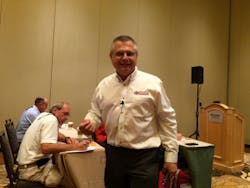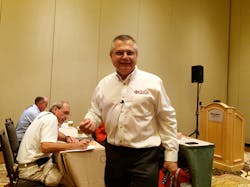PHCC Connect 2015: Customers do business with people not products
HOLLYWOOD, FLA. — Steve Coscia was talking about the Halo Effect, but it was a lot easier to show devil horns at work. The property manager was looking out the window, waiting for the service tech to show up. When he does, he opens the door to the van and fast food trash tumbles out. He stubs out his cigarette in the parking lot. No angel there.
Then Coscia showed a photo of the type of van too often seen in strip mall parking lots — the dashboard is filled with old mail, receipts, cigarette packs, fast food trash and parking tickets. No halo there either.
Coscia, one of the country’s pre-eminent experts in customer service and soft skills for service contractors, explained how customers view service providers at the Plumbing-Heating-Cooling Contractors CONNECT 2015 convention and show here in Florida in early October.
Coscia told the contractors that every time he would leave the house as a child, his Italian grandfather always told him, “buona figura,” literally “good figure,” but idiomatically it means, “make a good impression.” In order to buona figura, your service technicians need to create the halo effect.
Steve Coscia earns the Certified Speaking Professional designation
Harley Perry, Perry Plumbing, named Delta Faucet 2015 Contractor of the Year
Every company has a story, Coscia said, and your employees, especially the ones who interact with customers, need to be able to tell that story in order to create the halo effect that you want.
“In the absence of information, people make up their own,” he cautioned.
Coscia does a lot of ride-alongs with technicians and he visited with the maintenance engineer at a commercial property being serviced by a fire sprinkler contractor. Coscia asked the engineer why he used that sprinkler contractor.
The engineer had three priorities:
- Not have any trouble with the fire marshal.
- He likes working with smart people who know what they’re doing.
- When he calls the contractor with a problem, they take care of him.
Note, Coscia pointed out to the contractors, that none of those issues have anything to do with product.
You might see yourself at the top of the pyramid, but customers see your service technicians at the top — they’re probably the only representative of your company that customers see. The people stepping out of your trucks are your brand. The customer’s first impression of those folks might turn out to be their final decision.
It hinges on how people select service providers in an age when we can get so much information about different contractors. If they like you, they will look for more reasons to like you even more. If they don’t, they’ll gather data not to make a decision, but to justify not using you.
Coscia put a Venn Diagram up on the screen, those three intersecting circles where all three overlap in the middle. One of Coscia’s circles is synergy, that is, creating a whole that’s greater than the sum of its parts.
Another is effectiveness, prioritizing and completing work that brings the team closer to its goals. And the last circle is efficiency, how to do the work with economy, using the least amount of time and effort. The sweet spot is in the middle.
He pointed out that you can get the job done effectively and efficiently, but there’s no synergy. Or you can complete a job effectively but not very efficiently. So how do you hit the sweet spot? Ask your field crews, he said. They’ll tell you exactly how to get it done.
For your staff that the customer can’t see in person, it’s important that they handle every phone call just like it’s the first phone call not the call at 4:30. You might think that what your CSRs say is most important, but content only comes in fifth in the minds of customers.
The first is the pace of speech, because CSRs will start to rush through the greeting as it gets later in the day. The second is tone of voice, third is clarity, and fourth is empathy with the customer’s problem.
Contractors need to make their greeting standard operating procedure and enforce it, Coscia said. One contractor came back from a convention with the idea that his CSRs should say, “It’s a great day at …” They fought against it; it was too hokey, they said. The contractor enforced it, however, and over time he saw that the greeting had a psychological effect on his CSRs and improved the way they interacted with customers.
Coscia told the contractors that they need to shift the mindset of CSRs and sales people to make them relational. Some people have a transactional mindset — you provide goods and services and, in return, the customer gives you money.
Many customers find that approach cold and impersonal. A relational focus creates a more personal connection between the CSR, the company and they customer.
About the Author
Robert P. Mader
Bob Mader is the Editorial Director for Penton's mechanical systems brands, including CONTRACTOR magazine, Contracting Business and HPAC Engineering, all of which are part of Penton’s Energy and Buildings Group. He has been with CONTRACTOR since 1984 and with Penton since 2001. His passions are helping contractors improve their businesses, saving energy and the issue of safeguarding our drinking water. He is a graduate of the University of Notre Dame with an A.B. in American Studies with a Communications Concentration.

